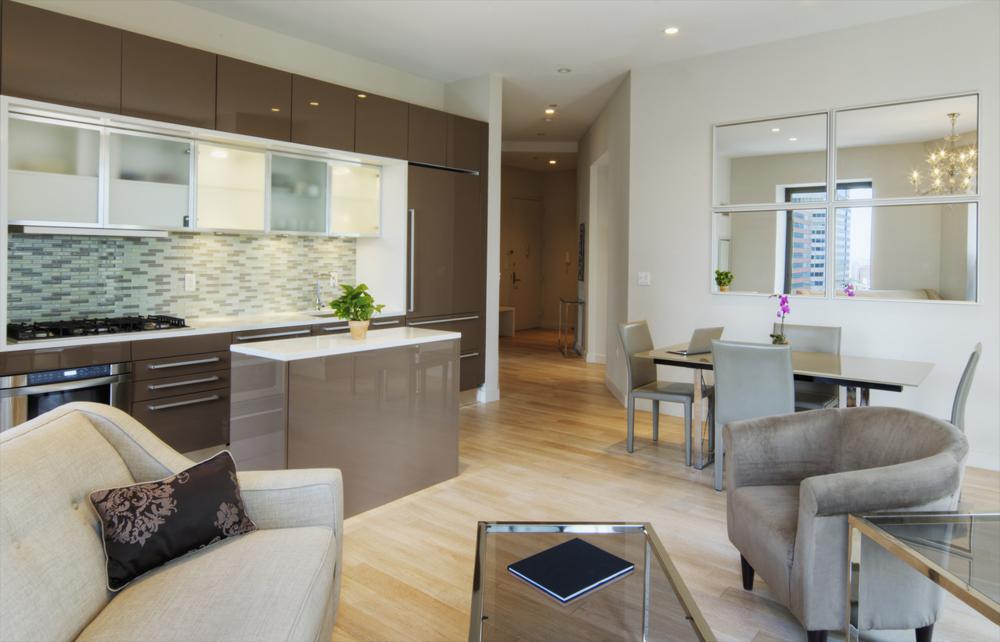
In today’s urban landscape, space optimization has become paramount, especially for small living spaces where the living room and kitchen often merge into a single multifunctional area. In such scenarios, crafting an efficient and aesthetically pleasing layout is key to maximizing functionality without compromising style. This article explores innovative for small living room kitchen combos, offering strategies for space optimization, layout design, lighting considerations, color palettes, and techniques to create visual continuity between spaces.
Space Optimization Strategies
Multifunctional Furniture
In the realm of small living spaces, every square inch counts. Multifunctional furniture pieces are the unsung heroes of compact design, offering versatility without sacrificing style. Convertible sofas and tables seamlessly transition between dining and lounging areas, while foldable chairs and desks provide extra seating and workspace when needed. Wall-mounted storage solutions, such as floating shelves and cabinets, capitalize on vertical space, keeping clutter at bay without encroaching on precious floor area.
Open Shelving and Vertical Storage
Embracing the vertical dimension is paramount in small living room kitchen combos. Open shelving not only adds visual interest but also creates an illusion of spaciousness by drawing the eye upward. Incorporating floating shelves above countertops and kitchen islands provides accessible storage for everyday essentials while maintaining an airy ambiance. Tall cabinets make the most of vertical space, offering ample storage for pantry items, cookware, and appliances without monopolizing valuable floor space.
Smart Organization Systems
Effective organization is the cornerstone of small space living. Drawer dividers and organizers optimize storage capacity, ensuring every inch is utilized efficiently. Lazy Susans and pull-out baskets maximize accessibility in kitchen cabinets, allowing for easy retrieval of items stored in the depths. Under-cabinet storage racks keep countertops clutter-free, providing designated spaces for spices, utensils, and cooking essentials within arm’s reach.
Layout Design Ideas
The Galley Layout
The galley layout, characterized by parallel countertops and a central walkway, is a popular choice for small living room kitchen combos. Its linear configuration maximizes efficiency by consolidating essential kitchen functions along one wall, leaving the opposite side open for seating or living area. While ideal for narrow spaces, the galley layout may pose challenges in terms of traffic flow and accessibility, requiring careful planning to optimize functionality without feeling cramped.
The L-Shaped Configuration
The L-shaped layout capitalizes on corner space, offering ample counter space and storage options while maintaining an open flow between the kitchen and living room. By angling the countertops along two adjacent walls, this configuration creates a natural division between cooking and lounging areas without sacrificing connectivity. Creative utilization of corner cabinets and built-in appliances maximizes efficiency, while strategic placement of furniture defines distinct zones within the open floor plan.
The Peninsula Setup
The peninsula setup extends from one of the kitchen walls, creating a partial division between the cooking and living areas while preserving visual continuity. Its versatile design offers additional countertop space for food preparation, dining, or casual seating, making it ideal for entertaining guests or everyday meals. Customization options abound, from incorporating breakfast bar seating to integrating storage cabinets or display shelves, allowing for tailored solutions that suit individual preferences and spatial constraints.
Lighting and Color Palette
Importance of Lighting in Small Spaces
In small living room kitchen combos, lighting plays a pivotal role in enhancing functionality and ambiance. Natural light infuses the space with warmth and vitality, making it feel more expansive and inviting. When natural light is limited, strategically placed artificial lighting sources, such as recessed ceiling lights, pendant fixtures, and under-cabinet LEDs, illuminate task areas and create a sense of depth and dimension.
Choosing an Optimal Color Scheme
Selecting the right color palette is paramount in small living room kitchen combos, as it can significantly impact the perceived size and atmosphere of the space. Light and neutral hues, such as soft whites, pale grays, and warm beiges, visually expand the space and reflect light, creating an airy and open feel. Introducing pops of color through accent walls, textiles, or décor accents adds personality and depth to the design, while maintaining visual cohesion between the kitchen and living areas.
Creating Visual Continuity Between Spaces
Flooring Options for Cohesiveness
Achieving visual continuity between the kitchen and living room begins with selecting cohesive flooring materials that seamlessly transition from one area to the next. Consistency in material, color, and finish creates a sense of unity and flow, blurring the boundaries between spaces and visually expanding the area. Incorporating rugs or runners in complementary tones and patterns defines distinct zones within the open floor plan while adding warmth and texture to the design.
Seamless Transition with Décor Elements
In addition to flooring, cohesive décor elements play a pivotal role in tying together small living room kitchen combos. Matching furniture styles and finishes create a sense of harmony and balance, while coordinating textures and materials add visual interest and depth. Incorporating décor accents, such as artwork, throw pillows, and area rugs, in complementary colors and patterns enhances the cohesive design narrative, creating a unified and inviting living space.
In conclusion, designing a small living room kitchen combo requires a strategic approach that balances functionality, aesthetics, and spatial constraints. By implementing space optimization strategies, thoughtful layout design, lighting considerations, and cohesive décor elements, homeowners can create harmonious and inviting spaces that maximize efficiency without compromising style. Whether embracing a galley layout, L-shaped configuration, or peninsula setup, the key lies in creative problem-solving and resourceful design solutions that elevate the living experience in compact urban dwellings.





